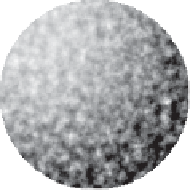Geoscience Reference
In-Depth Information
Water
Atmosphere
Energy
NO
3
PO
3-
4
O
2
CO
2
CO
2
PO
3-
4
O
2
Sediment
N
2
Organic matter, carbonate, phosphate,
silica, sulfide
Figure 8.2
Autotrophic life as a simple chemical plant. Nutrients are absorbed from the aqueous environment
(seawater or groundwater) while CO
2
needed for photosynthesis and O
2
needed for respiration
are ultimately derived from the atmosphere. Gaseous waste is also made of CO
2
and O
2
.
carbohydrates (sugar). The oxygenic synthesis of glucose may be represented by the formal
reaction:
6H
2
O
+
6CO
2
⇔
C
6
H
12
O
6
+
6O
2
(8.1)
Heterotrophs burn reduced carbon prepared by other organisms: they eat food and breathe.
Breakdown of glucose to pyruvate CH
3
-CO-COO
−
leads to ATP production in the
absence (fermentation) or in the presence (respiration) of a terminal electron acceptor, such
as sulfate or nitrate. Respiration is far more efficient than fermentation to produce ATP,
which explains why aerobic conditions and dissimilative reduction of nitrate, sulfate, and
iron are life's 'first choice'. Alternative sources, notably the energy of chemical reactions
(chemotrophs), are occasionally used.
Cell metabolism requires some major constituents and trace metals from its envi-
ronment. Obtaining C from CO
2
and H from H
2
O is rarely an issue as long as
a source of energy is present, but nitrogen must be tapped from either the atmo-
sphere or from dissolved nitrates. For phosphate groups, the only source is the PO
3
4
ion released into natural waters by weathering of continents. Oxygen is the waste of
photosynthesis, while CO
2
is the waste of respiration. Nitrate processing eventually
releases nitrogen and some phosphate also is eliminated in the ambient liquid medium
A second property of biomolecules is their widespread chirality (handedness): a
molecule can exist under two configurations which are the mirror image of each other













